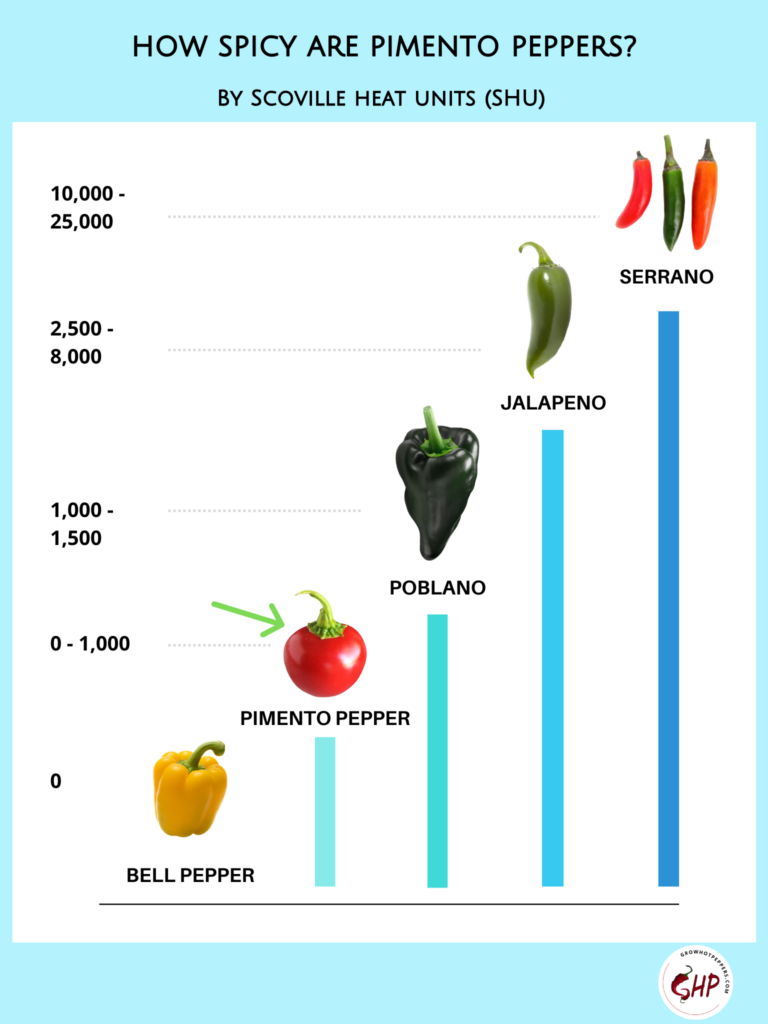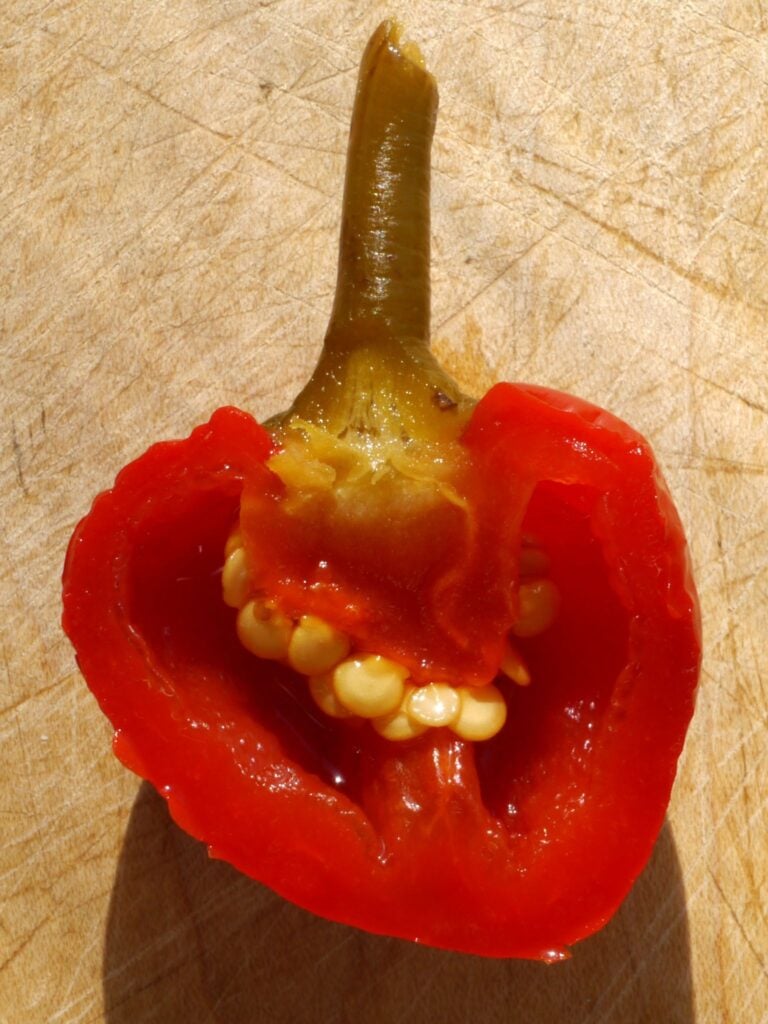Pimento peppers: you know them as the little red center in a stuffed green olive, the red flecks in southern Pimento cheese, or an important ingredient in the spice, Paprika. Pimentos are used in so many dishes, and you can grow them right in your garden.

Hot peppers are my favorite, but sweet ones like Pimentos are delicious too. Pimento peppers are one of those chiles that you might eat without realizing it. For example, in one of my favorite cocktails — dirty martini with olives. (I’m looking forward to having one this weekend! 🍸)
The word “pimento” derives from the Latin word “pigment.” It makes sense with their bright red hue. The vibrant Pimento peppers can look slightly heart-shaped or like squat pumpkins, depending on the variety.
Intrigued? We’ll dive into the facts about Pimentos, how to use them in your cooking, and how to grow them yourself.
PIMENTO PEPPER FACTS:
| Common Names | Pimento pepper, Pimiento pepper, Cherry pepper |
| Scoville Heat Units (SHU) | ~500 SHU |
| Capsicum Species | Capsicum annuum |
| Days To Harvest | ~75 days |
| Size | Peppers: 3-4 in (8-10 cm) long and 2-3 in (5-8 cm) wide. Plant: 2 ft (0.6 m) tall |
| Flavor | Mild, not spicy, sweet |
| Culinary Uses | Pimento cheese, stuffed olives, Paprika, garnishes, salads |
Let’s keep the Pimento momentum rolling!
What Are Pimento Peppers?

The Pimento pepper is a variety of chilli pepper with almost no heat (more on that below). From the nightshade family, their scientific name is Capsicum annuum. Pimentos can be used in cooking as an ingredient, spice, or garnish.
Known commonly as Pimento peppers, you will also see it spelled “Pimiento.” They are also sometimes called Cherry peppers.
Are Pimento Peppers Spicy?

The Pimento pepper Scoville level is anywhere from 0 to 1000 SHU. If you’re unfamiliar, the Scoville scale for peppers is how the spiciness of chilies gets classified.
To give you some more context, the Jalapeno Scoville is between 2,500 to 8,000 Scoville heat units. So a Pimento is really not spicy. In terms of heat, it only outranks the Bell pepper, which is completely sweet.
What Does A Pimento Pepper Taste Like?

Pimento peppers are a bit like Bell peppers in taste. This sweet pepper is more juicy than a Bell pepper though, and can contain just the teeniest amount of spice compared to a Bell pepper.
» Related: The Best Tasting Peppers to Grow for Beginners
What To Do With Pimento Peppers

What are Pimento peppers good for? So many things! For example, you can roast Pimentos, pickle them, dehydrate them for powder, and chop them up to top your meal, or mix them into soups, stews and antipasto salad.
Check out a few of the best Pimento pepper recipes below.
Pimento recipes around the web:
Pimento Substitutes

If you’re in a pinch with a recipe requiring Pimentos and you just don’t have access to any, you still have some backup options. Let’s go over what can you use in place of Pimento peppers.
You’ll want to substitute Pimentos with peppers that are similarly sweet and mild. An excellent contender would be red Bell peppers.
You can also consider substituting Pimentos with Peppadew peppers, Poblano peppers, or Banana peppers.
Grow Hot Peppers is reader-supported. When you buy through links on our site, we may earn a monetary commission. Learn more.
Where To Buy Pimento Seeds and Peppers
Look for Pimento pepper seeds in garden centers or online for more varieties. Pimento peppers usually come in jars or cans in a grocery store’s condiments aisle; fresh Pimento peppers may be at your local farmer’s market, but they’re harder to find.
Pimento seeds and peppers online:
» Tip: Use Instacart to search your local stores for “Pimento” or “Pimiento” products.
How To Grow Pimento Pepper Plants

It usually takes about six to seven months to harvest Pimento peppers after starting seeds indoors. Here’s an overview of all the Pimento pepper growth stages, from start to finish.
When To Start: Start Pimento pepper seeds indoors about eight weeks before your last expected frost (here’s a planting calculator to help). Pimento seeds typically sprout within one to two weeks.
Seed Planting: Sow your Pimento seeds in a slightly damp seed-starting mix, then cover your containers and position them over a plant heat mat to encourage germination. The best temperature for pepper seeds to sprout is between 80 to 90°F (27 to 32°C).
» Resource: Seed Starting Supplies (Top Picks)
Indoor Seedlings: Provide a plant grow light for your Pimento seedlings after they germinate, and use chilli fertilizer (1/4 strength) after the first set of true leaves grow. You can expect your seedlings to be inside for about two months before going outside.
Prepare for Outdoors: Transplant pepper seedlings to bigger pots as they grow larger, and then start hardening off plants to prepare them for the move outdoors. The hardening process starts when nighttime temperatures are regularly above 55°F (13°C) and the last expected frost has passed.
Fruiting Plants: Give your plants full sun (ideally 8 hours) and watch for flowers to grow, which means peppers will grow in the next couple of months! In general, you can expect to harvest Pimento peppers between two to three months after going outside.
First time growing peppers from seed?
Learn to grow peppers with my step-by-step, illustrated ebook. It’ll help you skip a lot of beginner mistakes so that you can enjoy harvesting your own chilies!
When To Pick Pimento Peppers
Pimiento peppers are typically harvested about 75 to 85 days after transplant when they’re about 4.5 inches (11.4 cm) long (depending on variety). Fully mature Pimientos are dark red and firm to the touch.
Pimento FAQs
Wrapping Up
Pimento peppers are versatile veggies that add a lovely red color and mild pepper flavor to your cooking. Grow them in your garden and enjoy fresh Pimento peppers any way you like!
Related Posts:

